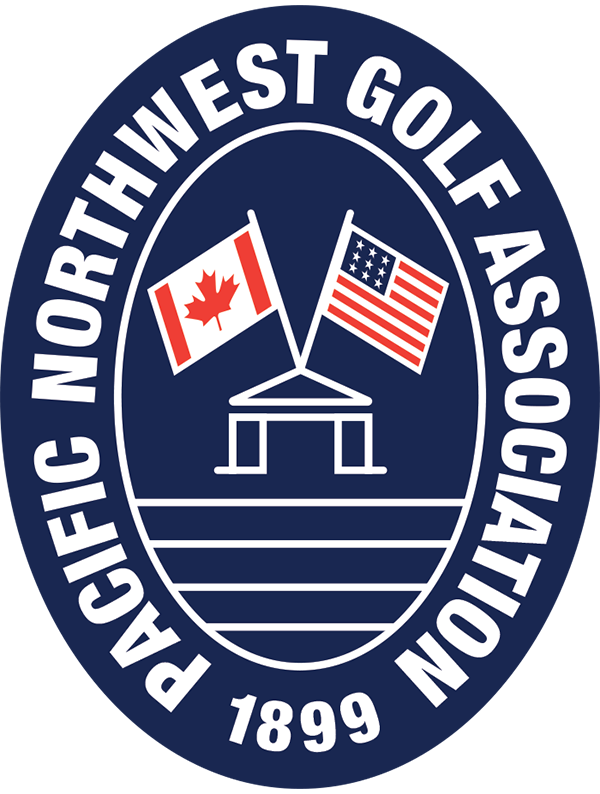It Was 20 Years Ago Today…
With this November issue, Pacific Northwest Golfer magazine reaches 20 years of publishing. Its history is more than that of a magazine – it is the history of the people who make up the golf industry in the region
by Paul Ramsdell
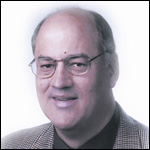
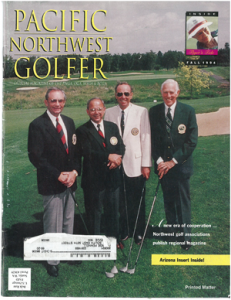
Through the years, most golf publications in the Northwest can be compared to your average bogey golfer.
A lot of times, everything comes together perfectly for a five- or six-hole stretch for that bogey golfer, but having all the components of the game come together perfectly for all 18 holes, and be able to shoot a 75, in a tournament no less…… well, that’s just not very common.
For the past couple of decades in the Northwest, a lot of golf publications have been able to rally for a five- or six-year stretch of existence, but being able to put everything together – the ad sales, the distribution, the editorial content, the creditability, the photography, the circulation numbers – well, not many have been able to sustain all that for 20 years.
This one has, though.
Pacific Northwest Golfer is celebrating its 20th anniversary this fall as the official publication of the Pacific Northwest Golf Association, British Columbia Golf, Idaho Golf Association, Oregon Golf Association and the Washington State Golf Association.
“It’s just a great, great communication tool,” said John Bodenhamer, the executive director of the PNGA when the magazine started in the fall of 1994. “It exceeded my expectations and I think everybody else’s.”
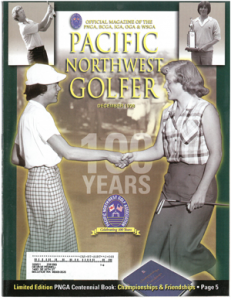
Raymond “Spike” Beeber of Portland was the chairperson of the PNGA Communications Committee when it all started and worked hand-in-hand with Bodenhamer to launch the project.
“In the background of all this, it’s a service to the members of the association,” Beeber said. “It’s not intended to make a lot of money. I didn’t have this in mind as a big moneymaker, but rather just being able to communicate with the members.”
Most years, the publication has made money for the PNGA. But not every year. Still, with a circulation of 123,000 and with direct-mail distribution in three states and one province, it’s accomplished more than others can imagine.
“I think it still might be the only profitable state and regional golf association publication in the country, for years I know it was,” said Bodenhamer, now the senior managing director for rules, competition and equipment standards for the USGA.
The magazine hasn’t rested on its laurels, or stayed stagnant, through those 20 years. Nor has it been afraid to stray from its roots.
“My attitude, I guess,” said Tom Cade, the current editor, “was I really wanted to open the doors on it and bring it out and make it not so much a traditional golf association publication. We really wanted to open it up and bring in outside stories for the golf community as a whole.”
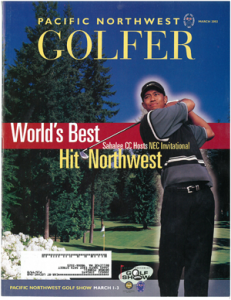
Now, he said, the most popular items in the magazine are the off-beat Q&A with selected golfers from each of the four regions, the regular Ask the Expert feature, and the page each issue featuring quirky photos of signs about golf.
“I get killed in my in-box with more photos every time that comes out,” Cade said.
The magazine was a killer at the start as well, just in a different way for Bodenhamer. “Every issue, the last couple of nights, I wouldn’t sleep for 48 hours because I was writing everything,” he said. “It was killing me, it really was.”
The idea to start the magazine came to Bodenhamer on two different fronts, starting back in 1992. Officials from the regional golf associations had gathered and the newsletters – the old, mimeographed, black and white, hard to read newsletters – from each association were spread out on a table. Bodenhamer was looking at the display with Bob Norquist, the director of junior golf for the OGA, who was saying it would be great if somehow, folks in Oregon could see golf results from state championships in Washington or British Columbia, and vice versa. Maybe the PNGA should look into that, Norquist said.
“It was Bob Norquist’s encouragement of me to start this, that’s how it started,” Bodenhamer said. “It was Bob’s idea and I was smart enough to listen to him.”
At about the same time, the PNGA was placing a few pages of content in Back Nine magazine to disperse PNGA news, and other publications were calling Bodenhamer asking him to do the same with their magazines.
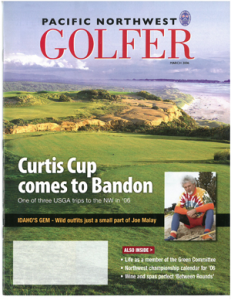
“They kept knocking on the door, saying you need this exposure; you need to do this; we can do this for you for this amount of money,” Bodenhamer said. “I just got to thinking if all these people wanted us in their magazine to get creditability and help them sell their magazine, and there’s nothing else in the Northwest, I just see this as an opportunity. My gut was just telling me there was an opportunity.”
Most on the PNGA Board of Directors, however, saw it only as an opportunity to lose money – save one, Spike Beeber.
“I thought it was a really good idea,” Beeber said. “And we’ve got to remember we were dealing with Bodenhamer at the time, and he hardly made any mistakes that I can remember.”
“It would not have happened had it not been for Spike,” Bodenhamer said.
Beeber convinced the Board to approve $30,000 in seed money. He expressed confidence they could sell $30,000 in advertising, and get 30,000 addresses to mail the magazine.
“I don’t want to say we went into it blindfolded, but we did go into it somewhat blindfolded,” Beeber said.
Bodenhamer thought potential advertisers would flock at the opportunity. Well, Doug McArthur bought the back page to promote the new Indian Summer G&CC, and JD Mowlds at Black Butte Ranch liked the concept and bought the second ad. Then it got tougher, a lot tougher. Bodenhamer and Beeber were able to secure about $10,000 in advertising, but the Nikes and the TaylorMades weren’t jumping on board. That’s when Stein Swenson came in and the advertising executive from Central Oregon saved the day by securing another $20,000 in advertising.
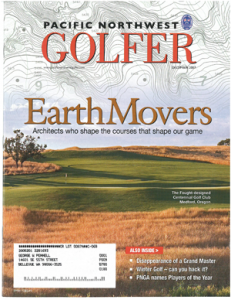
Possibly more difficult than advertising was getting the addresses. Pacific Northwest Golfer was going to set itself apart by being mailed to homes, not just something to be picked up from the stack on the bench leading into the locker room. That was a key element for potential advertisers as well. Getting into the homes of the lucrative demographics of golfers was crucial.
“We got the club addresses,” Bodenhamer said. “They were gold, they were the golden goose.”
It wasn’t easy. Mary Ramirez, a PNGA staffer, took charge of tabulating all the addresses, which weren’t a part of the handicap process at the time. Bodenhamer had to go to the exclusive private country clubs and ask for everyone’s home address, promising it was only for the delivery of the magazine and nothing more. It was a slow, hard sell.
“It was a real project, with a lot of people involved, with Bodenhamer’s ability to hold everything together,” Beeber said.
The first issue made nearly $30,000 in advertising revenue and was mailed to nearly 30,000 addresses, and Beeber was able to go back to the Board and say it was a success.
“Spike went into that meeting with his chest puffed out so far you couldn’t believe it,” Bodenhamer said.
For the first nine years of the magazine, all the editorial content was produced within the PNGA offices with Bodenhamer and Angie Wean, director of communications, leading the way.
In 2003, after too many sleepless nights for Bodenhamer, and with the opportunity to expand its regional footprint, the magazine was contracted out to an outside firm – PNGA Media, owned by John Tipping.
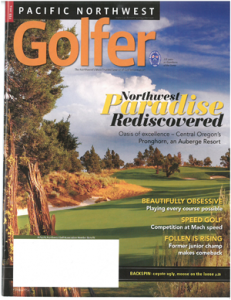
“It wasn’t some big company from out of state,” Tipping said of PNGA Media. “It wasn’t some corporate entity. It was a bunch of local people who loved golf and that love is obvious by the fact they are all still in the industry in some way or another; not only in the industry, they are leaders in the industry.”
PNGA Media also produced the Seattle Golf Show, and Cade was hired to lead that effort. Marilyn Esguerra was the art director for PNGA Media and continues in that role and has designed the magazine for the past 11 years.
“Personally rewarding was the amount of talent we were able to put together that’s sort of proven itself out over time,” Tipping said.
It wasn’t the best of times business-wise, however.
“We were also there at the most challenging time when it comes to print media,” Tipping said. “Print media was going through an upheaval because of everybody’s love with the Internet.”
PNGA Media produced the magazine for three years before it couldn’t handle the financial strain anymore.
In those three years, though, PNGA Media made great strides to regionalize the message, and besides Pacific Northwest Golfer, it also produced Golf British Columbia, Golf Idaho, Golf Oregon and Golf Northwest that were separate publications of the PNGA that were distributed to golf courses. Those magazines produced more news and more details about all four associations. It all helped bring the entire PNGA region closer together and working together more closely.
“That was the best thing we were able to accomplish for it,” Tipping said.
The magazine was brought back in house in 2007, and produced again within the offices of the PNGA. Cade was hired as editor to oversee the operation. An editorial committee was established and a group of freelance writers was enlisted to provide a variety of content.
“We really wanted to branch out and bring different voices into it from throughout the Northwest and we really made a concentrated effort to do that,” Cade said. “This was a brand new direction they were taking it.”
“Tom has done a terrific job,” Beeber said.
The regionalization has continued through zoned pages within the magazine, anywhere from eight to 32 separate pages for each state or province. It also enabled advertisers who can’t afford the big-ticket price of being in the entire region to be able to appear in their state or province pages and still be mailed to homes of golfers.
Through the 20 years of Pacific Northwest Golfer there have been numerous advancements, and of course, surprises. But producing a magazine really comes down to just one basic factor.
“I found very early that people actually read the magazine,” said Bodenhamer. “You can’t believe how many people would email me, or see me at a championship and say, ‘I don’t like what you said.’ Or, ‘I thought that was great.’ It was eye-popping.”
And being able to do it for 20 years is just as amazing.
Paul Ramsdell is the executive director of the Northwest Turfgrass Association and the Western Washington Golf Course Superintendents Association. From 2003-2006, he was the editor of Pacific Northwest Golfer magazine.
Key people connected to Pacific Northwest Golfer magazine over the years, or connected with golf in the Northwest, were asked about their favorite covers of the magazine, and their favorite articles. Here are some of the responses.
Troy Andrew, publisher of Pacific Northwest Golfer and executive director of the PNGA – For favorite cover, it’s September 2002 when the now hugely successful First Green program was just getting started and several key leaders in the start of that program were pictured aboard a tractor at Glendale Country Club. For favorite article, there are two. One is John Bodenhamer’s publisher’s essay in August 2012, “Tradition is worth preserving.” The other is a story by Blaine Newnham in September 2007 looking at golf courses you can see from your car window while driving Interstate 5 in Washington and Oregon.
John Bodenhamer, USGA’s senior managing director for rules, competitions and equipment standards – It’s tough to narrow it down for the former executive of the PNGA who in the past year has visited Argentina, Switzerland, France and Japan and elsewhere in his role with the USGA. For the cover, though, it’s tough to beat the first one in 1994. The presidents of the four associations within the PNGA gathered for a photo at the new OGA Members Course in Woodburn, Ore. He was not able to see the first edition come off the press because he was at meetings on the other side of the country, but a staff member quickly sent him some copies. “I remember opening up that FedEx package, and that was one of the greatest times to see that first magazine,” he said. He also said the photo of the four presidents was appropriate. “It was really a unifying moment,” he said. “From there, everybody had a piece of it, and everybody took great pride in it.” The entire issue was one of his favorites, because it also had a report on Tiger Woods winning the PNGA Amateur Championship at Royal Oaks. Another top cover was of Sahalee Country Club as it prepared for the PGA Championship in 1998. Other top articles were interviews with Paul Runyan, Fred Couples and Judy Bell.
Tom Cade, editor of Pacific Northwest Golfer and the senior director of communications for the PNGA – It’s the June of 2007 issue for his favorite cover. “That was a landmark issue for me, personally, because it was the first I really put my own style into,” he said. “That was the issue that had Chambers Bay on the cover because it had just opened, so they were the big story, and we had a bunch of other articles in there that were clearly not traditional association stories.” Another favorite is the February 2010 issue – after more than a year of struggling because of the recession, the magazine not only survived but produced its largest issue ever.
Peter Fibiger, chairman of the communications committee for the PNGA – For best cover, it’s May of 2011, with a sunset through the clouds onto the Nicklaus course at Pronghorn for the story “Best in the West” in preparation for the Pacific Amateur Golf Classic.
John Tipping, event producer for Cascadia Events – It’s the behind-the-scene story that makes the March 2004 cover his favorite. It was one of the first produced by PNGA Media and featured University of Washington golfers James Lepp and Brock Mackenzie on the ninth hole at Broadmoor Golf Club with the UW campus beautifully in the background. All this preparation seemed perfect, but the art director, Marilyn Esguerra, was flabbergasted by a major flaw. “She couldn’t believe that nobody had them iron their shirts,” said Tipping, who now produces five golf and industry trade shows.
Barb Trammell, CEO of the Oregon Golf Association – It’s the great photo of the December 2009 issue of “Work in Progress” at Chambers Bay that sticks out in her mind. And a story that stands out for her is from the September 2008 issue examining the history of Robert Hudson keeping the Ryder Cup alive after World War II by paying the way for the Great Britain team to come and play the 1947 matches at Portland Golf Club. The matches had not been played for 10 years before that.
Kris Jonasson, executive director of British Columbia Golf – For best cover, it’s the photos and graphic display of the December 2007 issue dealing with golf course architects. The favorite article comes every issue, with Backspin, where four golfers from around the region answer interesting questions about their golf lives.
— Paul Ramsdell
